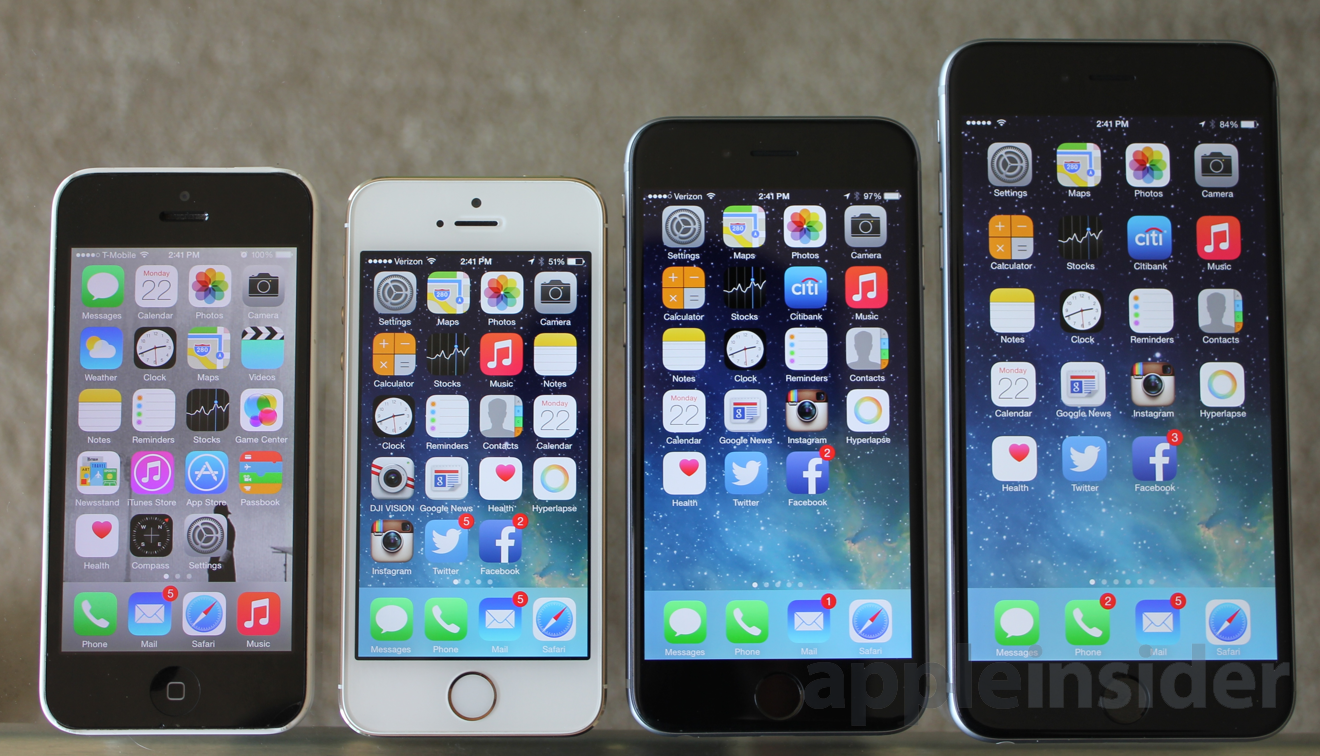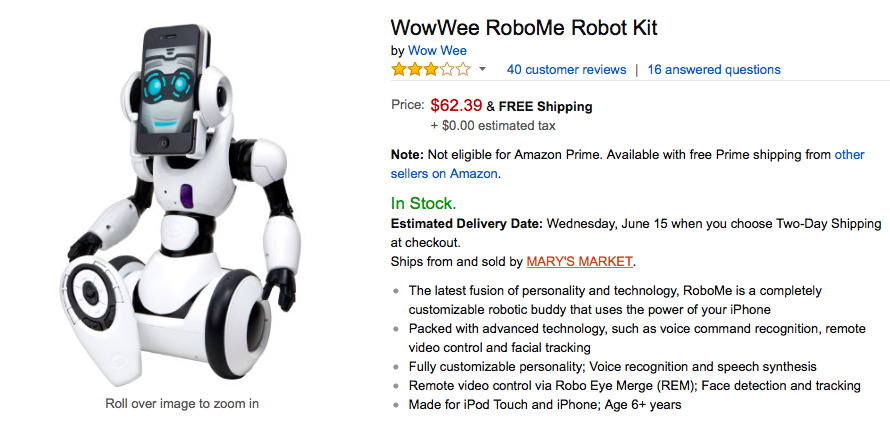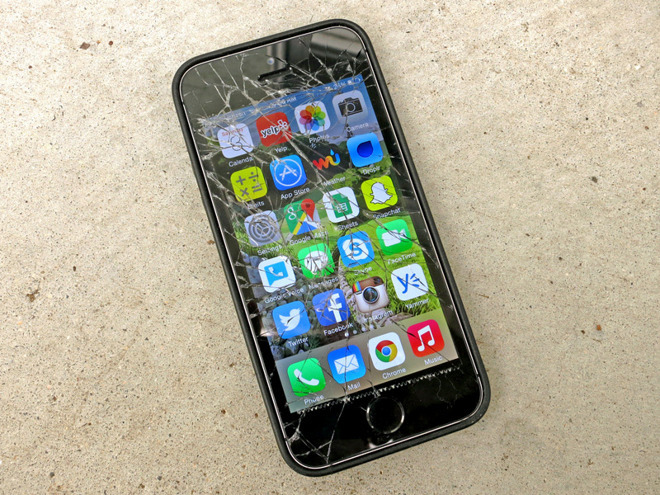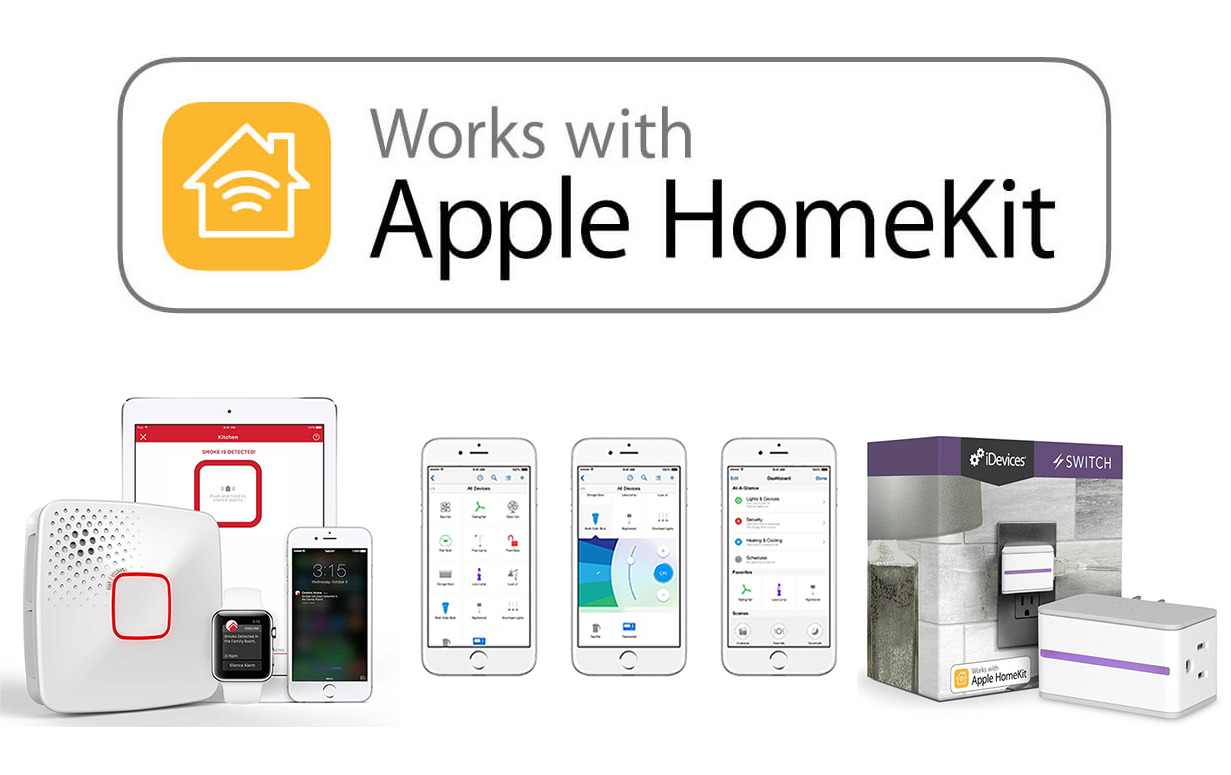Apple needs a reuse plan for 100s of millions of old iPhones: iOSR
As Apple prepares to show off its latest iOS 10 at Monday's Worldwide Developer Conference, it faces a purported threat of Peak iPhone sales, potentially complicated by a lengthening replacement cycle for new smartphones. But there's also another problem: how to recycle or otherwise manage the increasingly large volume of old iPhones it has already sold. The problem itself could offer a solution: a second life for old iPhones.
iPhone Glut?
Since the launch of iPhone 6, Apple has been producing over 200 million iPhones and 50 million iPads every year. Who's going to keep buying new ones? And just as importantly: what's going to happen to all of those old devices in two or three years as they begin to reach the end of their lifespan?
Some of those iPhones will be broken to the point of being destroyed. Apple has also implemented trade-in plans that refurbish usable iPhones for resale (something third party sites also do). It also recently demonstrated a sophisticated robotic recycling effort named Liam (portrayed below) that efficiently dismantles iPhones to recover the most usable and valuable materials from them.
However, in between the iPhones that are still new enough to be sold as a functional smartphone (and can be supported by the latest version of iOS) and those that can only be scrapped for materials, there is an increasingly large number of devices that contain high value electronics that could be reused for other purposes. Unleashing that power is something Apple could uniquely do.
iOSR: a second life for old iPhones
If Apple were to introduce a new version of iOS expressly designed to provide a second level of existence for its old phones, it would have a significant environmental impact (saving devices from landfills), but could also have a real economic impact that would broadly benefit everyone involved, from Apple to its users and partners.
Imagine if you had the option to take an older iPhone (such as an iPhone 4s or 5, currently valued at about $40-60 from Gazelle.com) and install a specialized "iOSR" onto the device. Rather than being optimized to work as a battery powered smartphone, the new software would turn the old iPhone into a general purpose embedded computer, re-tuned to serve as a WiFi and Bluetooth-enabled portable brain that could be applied to a variety of tasks or appliances.
You could plug it into a drone, install it in your car to record the road as you drive, connect it to a kitchen appliance or a desktop printer to supply new smarts and connectivity, stick it into the back of a mechanical robot body or a brainless-Roomba or any number of other devices that would benefit from wireless-connectivity, a quite-fast general purpose CPU and GPU, storage capacity, and motion controls.
This would enable manufacturers to build less expensive devices, appliances and toys that could be upgraded to a "smart" version by equipping them with an old iPhone. And when the old iPhone finally dies, you can swap it out for another one. After all, there are literally 100 million extra iPhones growing too old to be a phone any more every year, and that number is only going to increase.
Even if Apple were to actually run into Peak iPhone at some point, in three years there will be around 200 million older iPhones each year reaching basic obsolescence. That's a figure larger than the global production of desktop PCs by all vendors put together, or roughly equivalent to the global production of laptops. Conventional computers tend to stick around as a useful device for longer, but once they die, a very large percentage of them end up in landfills, not even being recycled.
Apple's efforts to recycle old iPhones is noteworthy, but more could be done to extend their useful lifespan by creating a different, post-phone existence for devices that are no longer new enough to support as modern smartphones.
Freed from the constraints of being a phone
To an extent, this can already be done (as depicted above in one the robot toys that can be outfitted with an iPhone). However, with some extra help from Apple, it could be turned into a significant second development platform. Rather than only building apps for iOS mobile users, Xcode could facilitate a second market for third party developers who now also build apps tuned for specific roles, running on a specialized iPhone running "iOSR" that's no longer bound to the constraints of being a phone.
One example: after about three years, an iPhone's battery is likely to begin reaching the end of its useful lifespan. It can't hold as much charge, and may eventually stop working entirely. By creating an iOSR platform that turns off battery power management entirely with the assumption that the device will be running off of supplied external power, the device could support an entirely new class of applications that wouldn't have to deal with iOS' current design which aggressively limits processing power, wireless connectivity and other features to maintain all day battery life.
Apple already has a "Made for iOS" (MFi) program that provides licensing and specifications to third parties that make cases, cables and wireless accessories. By expanding its existing program to create a new specification for adding a "lobotomized" iPhone to existing products, Apple could create a valuable secondary market for hundreds of millions of old iPhones, as well as creating demand for new software to run them.
The cost of custom-designing a compact ARM-based computer with 16GB of storage, Bluetooth, WiFi, sophisticated motion sensors and other components is out of the range of many smaller companies that could build a simple interface to their product enabling the end user to find and install an older iPhone to unlock extra capabilities.
Also, Apple's Xcode development tools are already in broad use by many thousands of companies that are already intimately familiar with coding on the iPhone's hardware. Put these together and you have a very efficient way to reuse the sophisticated processing power and wireless capabilities of recently built, older iPhones, one that is far more efficient than simply dismantling them and grinding them up into mostly low value, recycled materials.
The massive scale of iPhones
The rapid, relentless expansion of global iPhone sales has been so great over the last five years that it is hard to even comprehend the scale involved. iPhone 4 sold around 40 million units. iPhone 4S contributed another 60 million. iPhone 5 and the repackaged 5c contributed another 130 million devices, and iPhone 5s and the revamped SE represent about 150 million. The original iPhone 6 and 6 Plus sold 170 million more, and this year's 6s and 6s Plus are on track to distribute about as many more again.
While pundits have focused upon the ideas that "at some point, Apple can't grow anymore!" or alternatively, "who's going to want a new iPhone when their old one is now good enough!" the reality is that cell phones have always had a relatively short life span: old ones break or wear out and new ones keep getting better, justifying an upgrade to the best available technology.
Apple has already addressed the issues of what to do with old devices in a number of ways: offering take backs it can then refurbish and resell, and dismantling old phones that can't be sold for recycling. However, it can dramatically improve the efficiency of dealing with old devices by creating a new, valuable reuse cycle before needing to recycle a device into basic materials.
This is particularly worth investigating because it could also spark demand for new iPhone sales as users of old devices see the value of upgrading and repurposing their older device. The only alternative for 3-4 year old iPhones today is to trade them in for less than $50.
Increasing the value of old iPhones
iPhones hold onto a higher resale value than most other devices. In its first year, an iPhone retains about half of its brand-new retail value, an extraordinarily high figure when compared to other high end smartphones. Over its next two years, the resale price of functional iPhones slowly wind down by about $100 per year.
Apple currently maintains extraordinary backward compatibility in iOS for older iPhones. iOS 9 continues to support iPhone 4s, a model that is now nearly five years old. Compare that with Google's "pure Android" Galaxy Nexus which was introduced at the same time; that device wasn't even supported by the late 2013 release of Android 4.4 KitKat, let alone Google's current Android 6 Marshmallow.
Apple's exceptional history of supporting older devices for many years helps to extend the usable lifespan of these older devices, but also complicates the company's ability to capitalize on its newest technologies.
Apple will likely drop support for iPhone 4s with iOS 10, but it may still be at least another year before it can do the same for iPhone 5 and 5c. Once it does, it can focus exclusively on supporting devices with at least an A7 Application Processor with a 64-bit architecture capable of supporting Metal driven graphics. The downside of ending support for older devices is that it will render roughly 200 million iPhones stuck on older versions of iOS.
It would be preferable to Apple to trade those users up to a new phone. The company has also looked into refurbishing older phones for resale in emerging markets where users can't afford a new $650 product, particularly after import taxes and duties and currency changes inflate the price to an even higher figure than Americans pay. But in some cases, refurbishing a phone isn't really practical.
An older device with a cracked screen, a scuffed up case and a dying battery would require extensive repairs to be sold as a refurbished iPhone. But if it were made available as a device capable of powering the brains of a cheap drone, or plugged into the sensors of convection oven, or plugged into the back of a television, or installed in a vehicle, or incorporated into an environmental sensor, it could supply several more years of after-life duty that could take full advantage of its processor, sensors and wireless connectivity features.
It would be a cheap way for Apple to expand its iOS device ecosystem and development platform. It would create a valuable new role for users' old products. And it would open up a new market for developers who are struggling to find attention for their smartphone apps. Additionally, it would further attract new buyers to Apple's iOS ecosystem, aware that after they choose to upgrade in a year or two, they could repurpose their old iPhone into a new, valuable role as something else.
Unique to iPhones
There are a few reasons why Apple is uniquely capable of creating a significantly large aftermarket for its old phones. First of all, it's the only company to produce very large numbers of identical devices. While Samsung produces about 80 million handsets every quarter (compared to about 50 million for Apple), those vary dramatically in their physical design and also in their chipsets, sensors and processing power.
Only about 9 million of the phones Samsung sold in the last quarter were its fancier Galaxy S7, but even that device is sold with multiple processor versions, differing GPU architectures, and in variant hardware designs. The other 71 million or so Samsung phones range from big screens to basic tier devices that can barely run apps. It's this vast fragmentation of hardware that helps make it so hard for Samsung to even distribute Android updates and security patches from Google to its users even over their first year, let alone the five years of support Apple maintains for iPhones.
Samsung's phones— along with most low-end Androids— are also a lot more poorly built because they are designed to be sold at an Average Selling Price of around $200. Most of Apple's iPhones were designed to be sold at around $650. Additionally, Apple has historically only changed the basic body type of iPhones three times over the last six years: 4/4s, 5/5s/5c, and 6/6s (with Plus variants).
Each of these generations also has a well known set of standard capabilities, a very consistent architecture for its motion sensors and other hardware characteristics, and all run the same platform version, without requiring special drivers for oddball hardware variations. This would make it much easier to specify an iPhone as the "third party brain" for variety of applications where device consistency and predictable accuracy are important. Depending on the task, a vendor could recommend a minimum specification of used iPhone required, such as at least an iPhone 5 using a Lightning cable.
Inspired by Japanese Shaken
Apple could take inspiration from Japan, where rigid Shaken regulations on auto safety and maintenance make it increasingly expensive to own older cars after only a few years of driving. As a result, Japan exports massive numbers of perfectly functional, high quality, low mileage engines and transmissions to poorer neighboring countries. Those engines commonly find a second life serving as the power plant for boats and jitneys, and some even make their way to the U.S. as a replacement engine for vehicles here, where car owners frequently keep their vehicles in use for a decade.
As it would with iPhones, this encourages the Japanese to buy new cars, while also providing a useful product others can continue to use at an affordable price. One difference: the Japanese auto industry only produces about 5.5 million new cars each year for domestic use. Apple sold about 15.5 million iPhones in Japan last year. That highlights the potential for broad reuse of old iPhones in virtually every market Apple currently does business in.
Japanese Shaken laws also have another impact on car buying behavior in the country. Rather than shopping for cars with an intent for longevity, Japanese consumers tend to look for innovative features they can enjoy over the 2-4 years of functional ownership they might expect to have. This promotes innovation among Japanese manufacturers focused on building increasingly better vehicles, rather than basic cars that can be expected to last for a decade.
Apple has many of the same interests. In fact, Apple's future in the smartphone industry depends upon its ability to identify useful new capabilities and features that will appeal to millions of smartphone buyers willing to pay a premium for excellent devices that feel luxurious and deliver compelling functionality.
By creating an iOSR software release, Apple could focus its attention on optimizing iOS for three year old iPhones (the models it is currently selling: iPhone 5s, SE, 6 and 6s), while providing a secondary OS release that turns older iPhones into a valuable alternative device that's no longer a phone (although those devices could be returned to normal operation by simply reinstalling iOS).
With iOSR installed, the phone would become a device that developers could target with creative apps that turn it into the brains of a low cost portable speaker system, or incorporate it into a security system that's capable of quickly obtaining HomeKit certification, or any number of other smart, connected "Internet of things" devices.
Some of these same concepts could also apply to iPads and Macs, but Apple builds and sells these other devices on a much smaller scale. By creating a new iOSR version alongside the mainstream iOS, Apple could immediately shape the development of tens of millions of "new" smart devices, all powered by very capable but no longer cutting edge iPhone hardware.
After launching an iOSR package capable of converting old iPhones into a general purpose brain, Apple could potentially even establish demand for significant new volumes of new, stripped down modules that are essentially an iPod touch without a battery, for use with iOSR in industrial applications or as building block for use in education— a sort of corporate feet vehicle.
Whether reused or new, iOSR devices would all run iOS-based apps, support the potential for innovative Continuity integration with new iPhones, enlarge the installed base of HomeKit products (expanding to cameras, security systems and other devices that could be managed by an older iPhone), and potentially make use of iCloud storage or tap into the user's Apple Music subscription in their new lives as the brain behind smart-something devices.
Apple operates its iOS App Store and builds its Xcode development tools, not to bring in major direct revenues, but to support an ecosystem that promotes the value of its premium hardware. With a relatively minor extension of Xcode and its MFi licensing program, and a parallel iOSR platform distribution designed to convert old iPhones into a general purpose iBrain, the company could create a second stage of useful life for older iPhones, promote a faster upgrade cycle to its newest hardware and expand the app market for its third party partners, all at a relatively low cost and effort.
 Daniel Eran Dilger
Daniel Eran Dilger














 Wesley Hilliard
Wesley Hilliard
 Andrew Orr
Andrew Orr



 Amber Neely
Amber Neely

 William Gallagher
William Gallagher







